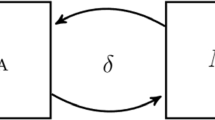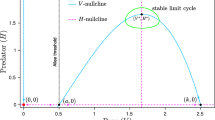Abstract
We propose a general mathematical model describing the growth and dispersal of a single species living in a 1-D spatially discrete array of habitat patches affected by a sustained and directional change in climate. Our model accounts for two important characteristics of the climate change phenomenon: (1) Scale dependency: different species may perceive the change in the environment as occurring at different rates because they perceive the environment at different scales, and (2) measure dependency: different species measure the environment differently in the sense that they may be sensible to or cue in on different aspects of it (e.g., maximum temperature, minimum temperature, accumulated temperature) which is associated with their physiological, ecological, and life history attributes, which renders some characteristics of the environment more biologically relevant than others. We show that the deterioration in the quality of habitable patches as a consequence of climate change drives the species to extinction when dispersal is not possible; otherwise, we proof and provide a numerical example that, depending on the velocity of climate change, the scale at which a species measures it, and the particular attribute of the environment that is more biologically relevant to the species under analysis, there is always a migration strategy that allows the persistence of the species such that it tracks its niche conditions through space, thus shifting its geographic range. Our mathematical analysis provides a general framework to analyze species’ responses to climate change as a relational property of a given species in interaction with a change in climate. In particular, we can analyze the persistence of species by taking into account the ways in which they measure and filter the environment. Indeed, one of our main conclusions is that there is not a single climate change but many, as it depends on the interaction between a particular species and climate. Thus, the problem is more complex than assumed by analytically tractable models of species responses to climate change.





Similar content being viewed by others
References
Alley RB, Marotzke J, Nordhaus WD, Overpeck JT, Peteet DM, Pielke Jr RA, Pierrehumbert RT, Rhines PB, Stocker TF, Talley LD, Wallace JM (2003) Abrupt climate change. Science 299:2005–2010
Alward RD, Detling JK, Milchunas DG (1999) Grassland vegetation changes and nocturnal global warming. Science 283(5399):229–231
Araújo MB, Ferri-Yáñez F, Bozinovic F, Marquet PA, Valladares F, Chown SL (2013) Heat freezes niche evolution. Ecol Lett 16(9):1206–1219
Arim M, Abades SR, Neill PE, Lima M, Marquet PA (2006) Spread dynamics of invasive species. Proc Natl Acad Sci USA 103(2):374–378
Berestycki H, Diekmann O, Nagelkerke CJ, Zegeling PA (2009) Can a species keep pace with a shifting climate? Bull Math Biol 71(2):399–429
Berg MP, Kiers E, Driessen G, Van Der Heijden M, Kooi BW, Kuenen F, Liefting M, Verhoef HA, Ellers J (2010) Adapt or disperse: understanding species persistence in a changing world. Glob Chang Biol 16(2):587–598
Chase JM, Leibold MA (2003) Ecological niches: linking classical and contemporary approaches. University of Chicago Press, Chicago
Chen I, Hill J, Ohlemüller R, Roy D, Thomas C (2011) Rapid range shifts of species associated with high levels of climate warming. Science 333(6045):1024–1026
Chevin LM, Lande R, Mace GM (2010) Adaptation, plasticity, and extinction in a changing environment: towards a predictive theory. PLoS Biol 8(4):e1000,357
Davis AJ, Jenkinson LS, Lawton JH, Shorrocks B, Wood S (1998) Making mistakes when predicting shifts in species range in response to global warming. Nature 391(6669):783–786
Dullinger S, Dirnböck T, Grabherr G (2004) Modelling climate change-driven treeline shifts: relative effects of temperature increase, dispersal and invasibility. J Ecol 92(2):241–252
Duputié A, Massol F, Chuine I, Kirkpatrick M, Ronce O (2012) How do genetic correlations affect species range shifts in a changing environment? Ecol Lett 15(3):251–259
Forchhammer MC, Post E, Stenseth NC, Boertmann DM (2002) Long-term responses in arctic ungulate dynamics to changes in climatic and trophic processes. Popul Ecol 44
Gornish ES, Tylianakis JM (2013) Community shifts under climate change: Mechanisms at multiple scales. Am J Bot 100(7):1422–1434
Hannah L (2014) Climate Change Biology. Academic Press
Hansen AJ, Neilson RP, Dale VH, Flather CH, Iverson LR, Currie DJ, Shafer S, Cook R, Bartlein PJ (2001) Global change in forests: Responses of species, communities, and biomes. Bioscience 51 (9):765–779
Hansen BB, Grøtan V, Aanes R, sæther BE, Stien A, Fuglei E, Ims RA, Yoccoz NG, Pedersen ÅØ (2013) Climate events synchronize the dynamics of a resident vertebrate community in the high Arctic. Science 339(6117):313–315
Hoegh-Guldberg O, Hughes L, McIntyre S, Lindenmayer DB, Parmesan C, Possingham HP, Thomas CD (2008) Assisted colonization and rapid climate change. Science 321(5887):345–346
Hutchinson G (1957) Concluding remarks. Cold Spring Harb Symp Quant Biol 22:415–427
Kearney M, Porter W (2009) Mechanistic niche modelling: combining physiological and spatial data to predict species ranges. Ecol Lett 12(4):334–350
Keitt TH, Lewis MA, Holt RD (2001) Allee effects, invasion pinning, and species’ borders. Am Nat 157 (2):203–216
Kot M, Phillips A (2015) Bounds for the critical speed of climate-driven moving-habitat models. Math Biosci 262:65–72
Lenoir J, Gégout J C, Marquet PA, de Ruffray P, Brisse H (2008) A significant upward shift in plant species optimum elevation during the 20th century. Science 320(5884):1768–1771
Leroux SJ, Larrivée M, Boucher-Lalonde V, Hurford A, Zuloaga J, Kerr JT, Lutscher F (2013) Mechanistic models for the spatial spread of species under climate change. Ecol Appl 23(4):815–828
Levin SA (1992) The problem of pattern and scale in ecology: the Robert H. MacArthur award lecture. Ecol 73(6):1943–1967
Li B, Bewick S, Shang J, Fagan WF (2014) Persistence and spread of a species with a shifting habitat edge. SIAM J Appl Math 74(5):1397–1417
Loarie SR, Duffy PB, Hamilton H, Asner GP, Field CB, Ackerly DD (2009) The velocity of climate change. Nature 462(7276):1052–1055
Morin X, Thuiller W (2009) Comparing niche-and process-based models to reduce prediction uncertainty in species range shifts under climate change. Ecol 90(5):1301–1313
Nathan R, Klein E, Robledo-Arnuncio JJ, Revilla E (2012) Dispersal kernels: review. In: Clobert J, Baguette M, Benton T G, Bullock J M (eds) Dispersal Ecology and Evolution, Oxford University Press, pp 187–210
Parmesan C (2006) Ecological and evolutionary responses to recent climate change. Annual Review of Ecology, Evolution, and Systematics 637–669
Parmesan C, Yohe G (2003) A globally coherent fingerprint of climate change impacts across natural systems. Nature 421(6918):37–42
Pearson RG (2006) Climate change and the migration capacity of species. Trends Ecol Evol 21(3):111–113
Pease CM, Lande R, Bull JJ (1989) A model of population growth, dispersal and evolution in a changing environment. Ecol 70:1657–1664
Peng S, Huang J, Sheehy JE, Laza RC, Visperas RM, Zhong X, Centeno GS, Khush GS, Cassman KG (2004) Rice yields decline with higher night temperature from global warming. Proc Natl Acad Sci U S A 101(27):9971–9975
Perry AL, Low PJ, Ellis JR, Reynolds JD (2005) Climate change and distribution shifts in marine fishes. Science 308(5730):1912–1915
Peterson AT, Soberón J, Pearson RG, Anderson RP, Martinez-Meyer E, Nakamura M, Araújo MB (2011) Ecological niches and geographic distributions (MPB-49). 49, Princeton University Press
Pfender WF, Vollmer SS (1999) Freezing temperature effect on survival of Puccinia graminis subsp. graminicola in Festuca arundinacea and Lolium perenne. Plant Dis 83(11):1058–1062
Post E, Forchhammer MC (2001) Pervasive influence of large-scale climate in the dynamics of a terrestrial vertebrate community. BMC Ecol 1(1):5
Potapov A, Lewis M (2004) Climate and competition: the effect of moving range boundaries on habitat invasibility. Bull Math Biol 66(5):975–1008
Stocker T, Qin D, Plattner G, Tignor M, Allen S, Boschung J, Nauels A, Xia Y, Bex B, Midgley B (2013) IPCC, 2013: climate change 2013: the physical science basis. contribution of working group i to the fifth assessment report of the intergovernmental panel on climate change
Taylor CM, Hastings A (2005) Allee effects in biological invasions. Ecol Lett 8(8):895–908
Thomas CD, Cameron A, Green RE, Bakkenes M, LJ <Beaumont, Collingham YC, Erasmus B, de Siqueira MF, Grainger A, Hannah L, Hughes L, Huntley B, van Jaarsveld AS, Midgley GF, Miles L, Ortega-Huerta MA, Peterson AT, Phillips OL, Williams SE (2004) Extinction risk from climate change. Nature 427(6970):145– 148
Thuiller W, Lavorel S, Araújo M B, Sykes MT, Prentice IC (2005) Climate change threats to plant diversity in europe. Proc Natl Acad Sci USA 102(23):8245–8250
Thuiller W, Münkemüller T, Lavergne S, Mouillot D, Mouquet N, Schiffers K, Gravel D (2013) A road map for integrating eco-evolutionary processes into biodiversity models. Ecol Lett 16(s1):94–105
Walther GR (2000) Climatic forcing on the dispersal of exotic species. Phytocoenologia 409–430
Walther GR, Post E, Convey P, Menzel A, Parmesank C, Beebee TJC, Fromentin JM, Hoegh-Guldberg O, Bairlein F (2002) Ecological responses to recent climate change. Nature 461(6879):389–395
Watkinson AR, Sutherland WJ (1995) Sources, sinks and pseudo-sinks. J Anim Ecol 126–130
Zhou Y, Kot M (2011) Discrete-time growth-dispersal models with shifting species ranges. Theor Ecol 4 (1):13–25
Acknowledgments
We acknowledge the main funding from FONDECYT 3140613 postdoctoral grant to Mauricio Tejo, and the partial support of CONICYT 21110386 Ph.D scholarship program to Cristián Vásquez, projects ICM-MINECOM, P05-002 IEB, Programa de Financiamiento Basal, CONICYT PFB-23 and FONDECYT 1161023 to Pablo A. Marquet and project “Stochastic Analysis Research Network” PIA-CONICYT-ACT1112, PIA-CONICYT-SOC1405, and VRI-PUC Program on Biostochastics. We thank Rolando Rebolledo and the members of the ANESTOC center for insightful and stimulating discussion during the preparation of our work.
Author information
Authors and Affiliations
Corresponding author
Electronic supplementary material
Below is the link to the electronic supplementary material.
Rights and permissions
About this article
Cite this article
Tejo, M., Niklitschek-Soto, S., Vásquez, C. et al. Single species dynamics under climate change. Theor Ecol 10, 181–193 (2017). https://doi.org/10.1007/s12080-016-0321-0
Received:
Accepted:
Published:
Issue Date:
DOI: https://doi.org/10.1007/s12080-016-0321-0




